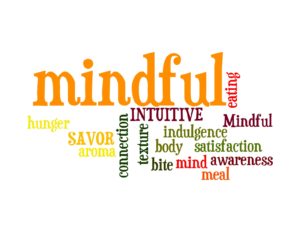
Andrea Miller MHSc, RD
April 2016
Mindful eating involves paying full attention to the experience of eating and drinking. It involves paying attention to the colors, smells, textures, flavors, temperatures, and even the sounds (crunch!) of our food. Many social and environmental factors can stand in the way of being able to eat mindfully. Mindfulness helps us break free from routine eating habits by examining the thoughts, feelings and internal pressures that affect how and why we eat.
By using all of our senses when eating food that is both satisfying and nourishing, acknowledging our responses to food (likes, dislikes or neutral) without judgment, and becoming aware of physical hunger and satiety cues to guide decisions to begin and end eating, we can change our relationship with food.
Mindful eating helps individuals learn how to check in with their direct experience when eating. Reconnecting to your direct sensory experience can become the start of a food and eating awakening. People often discover that the flavor of common foods can be transformed by bringing a mindfulness practice to the meal.
Principles of Mindfulness:
- Mindfulness is deliberately paying attention, non-judgmentally, in the present moment.
- Mindfulness encompasses both internal processes and external environments.
- Mindfulness is being aware of your thoughts, emotions and physical sensations in the present moment.
- With practice, mindfulness cultivates the possibility of freeing yourself of reactive, habitual patterns of thinking, feeling and acting.
- Mindfulness promotes balance, choice, wisdom and acceptance of what is.
Mindful eating is:
- Allowing yourself to become aware of the positive and nurturing opportunities that are available through food selection and preparation by respecting your own inner wisdom.
- Using all your senses in choosing to eat food that is both satisfying to you and nourishing to your body.
- Acknowledging responses to food (likes, dislikes or neutral) without judgment.
- Becoming aware of physical hunger and satiety cues to guide your decisions to begin and end eating.
Click here for more information.
Tips for eating mindfully:
- Eat slowly: Taking the time to savor and enjoy your food is one of the healthiest things you can do.
- Eat without distractions: make mealtime an electronics free zone
- Enjoy flavours: pay attention to the unique flavours in everything you eat
- Connect with your food; grow herbs, visit a farmers market, try a new recipe- connecting with what you eat increases mindfulness.
Try a mindful eating activity:
Try taking the first bite of your meal with your full attention? Notice the smells, taste and feelings you have with this food.
If you are reading or working while eating, try to take a break so you can focus on only eating.
Try eating one meal a week mindfully, alone and in silence. Be creative. Eat lunch without any distractions- no phone, no computer etc. Pay attention to all sensations, while eating this meal.
Resources for Mindful Eating:
- Mindful Eating: A Guide to Rediscovering a Healthy and Joyful Relationship with Food, by Jan Chozen Bays
- Mindless Eating: Why We Eat More Than We Think, by Brian Wansink
- Eat What You Love, Love What You Eat, By Michelle May
- Intuitive Eating, A Revolutionary Program that works, By Evelyn Tribole, Elyse Resch
- The Centre for Mindful Eating

